Best Cockroach Killer for Around Outsode of House
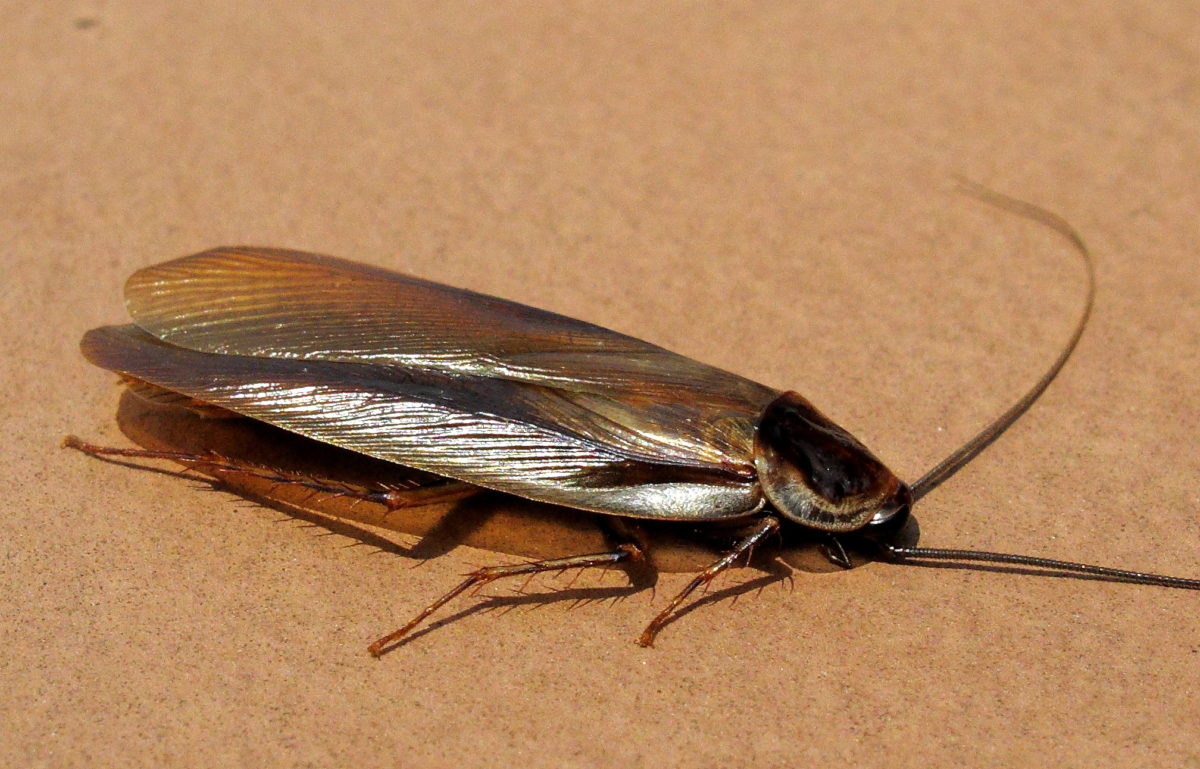
When about people think about cockroaches, feelings of cloy encompass them imagining these filth and germ-ridden pests scurrying across surfaces within the home.Withal, not all cockroaches live indoors. Various types prefer an outdoor habitat where they still reside in filth, clay and droppings. We've outlined the nigh common outdoor cockroach species, their hiding places and what yous tin do in the form of pest-control and preventing your outdoor roach problem.
Cockroaches: The Basics
Cockroaches have been crawling around the planet for over 300 million years and because they seem so indestructible, some believe they'll be the just survivors of a nuclear holocaust. With over 4,500 known species of cockroaches and around 69 species of cockroaches calling the United States home, the roach family unit is quite large.
According to the Academy of Florida, outdoor cockroaches serve a role. They function as decomposers, existing past feeding upon dead and dying found matter, also as expressionless animals. Even outdoor roaches pose wellness hazards to humans, as they are carriers of diseases including Salmonella. They as well spark allergic reactions in some people, causing asthma and skin disorders. Therefore, dealing with an outdoor roach problem is imperative before the germ-ridden pest finds a way indoors.
Common cold Climate versus Warm Climate
If there's anything positive about outdoor cockroaches, y'all're likely to come across simply several of the six most mutual roaches that call the great outdoors their home. In addition, not all of these cockroach species reside in both the colder regions of the Usa and the warmer areas.
Those living in colder northern locales will encounter a reduction in outdoor cockroach infestations as the weather cools in fall and wintertime. On the other hand, those living in southern regions or consistently warm areas of the United States volition bargain with outdoor cockroach infestations twelvemonth-round, as the warmer temperatures allow the cockroaches to be active all year. This raises your level of pest-command efforts to keep the outdoor roach problem nether command.
Typical Outdoor Cockroach Hiding Places
Regardless of where you live in the United states of america, you'll find that all species of cockroaches prefer the same type of outdoor hiding places in the landscape. The offset and maybe the most of import stride in cockroach command and eliminating your outdoor roach problem is locating their hiding places. This allows you to perform important pest-control and prevention tactics where the roaches feel nearly at home.
Cockroaches are nocturnal, so y'all'll find most action in the evening hours when they come out to feed, although during the daylight they'll most likely be hanging out in their hiding place. Mutual outdoor places where cockroaches hide include:
- Flowerbeds, especially in mulch
- Piles of forest
- Garbage Cans
- Open up Compost Piles
- Damp areas
- Outdoor nutrient sources
- Sewage systems
- Trash piles
- Areas with high organic matter
- Piles of leaves and organic droppings
- Inside tree holes and trees like palm trees
One time you discover where the cockroaches are hiding during the day, you can and then carry out your prevention and pest-control options to control the population and prevent further infestations that can assistance in preventing the roaches from making their fashion indoors.
Common Outdoor Cockroach Species
Sure species of roaches adopt to nest in certain locations in the landscape. Some of these species adopt to remain in an outdoor environment and merely mistakenly make their way indoors, while some types can besides live quite happily invading your indoor spaces. Many types of outdoor roaches volition attempt to find an entry point into the domicile when outdoor conditions are especially hot and dry.
Common roach species you lot are likely to find outdoors include:
Florida Woods Cockroach
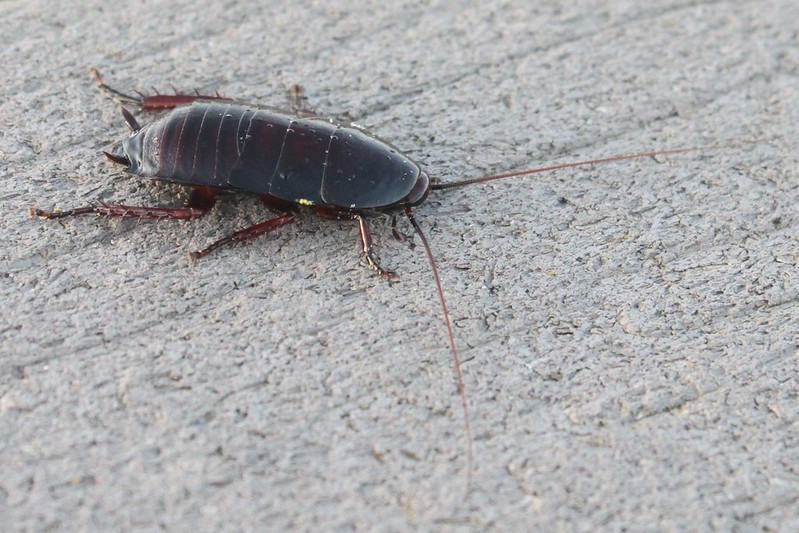
Forest cockroaches' name says it all — they prefer to alive outdoors and cannot alive for long in an indoor environment. The insects range in size from around 3/iv inches long to ane 1/4 inches in length and are tannish to light dark-brown in color. Outdoors, they prefer living in clammy areas like mulch piles, rotten logs, woodpiles and under the loose bawl in copse. Alice Covington, a horticultural specialist with Nelson's Landscape and Plant nursery in Grant, Fla., notes, "Don't be surprised to detect 1 when you dig in the soil of your flower beds while doing garden maintenance or planting."
American Cockroach
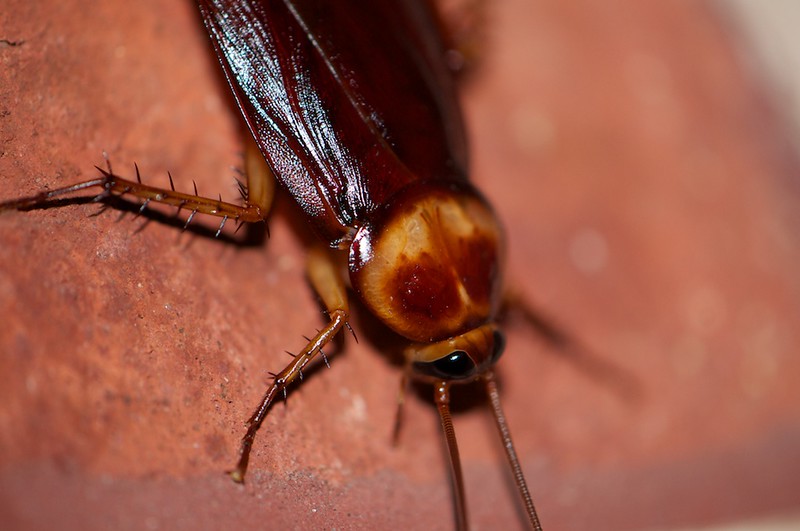
The largest of the cockroach species establish in the United States and often referred to equally palmetto bugs, American cockroaches average around 2 inches long are a red-brownish color with a yellow figure-eight design on their head. American cockroaches happily brand their homes both outside and inside the home, preferring warm and humid outdoor locations. When the weather cools in winter, the cockroach will make its way indoors through available entry points. Preferred outdoor locations are compost piles, trash cans and trash piles, moist areas and around sources of water, in mulch and in decaying plant debris, sewer systems, steam tunnels, wood piles and pet feeding areas. American cockroaches can fly.
Oriental Cockroach
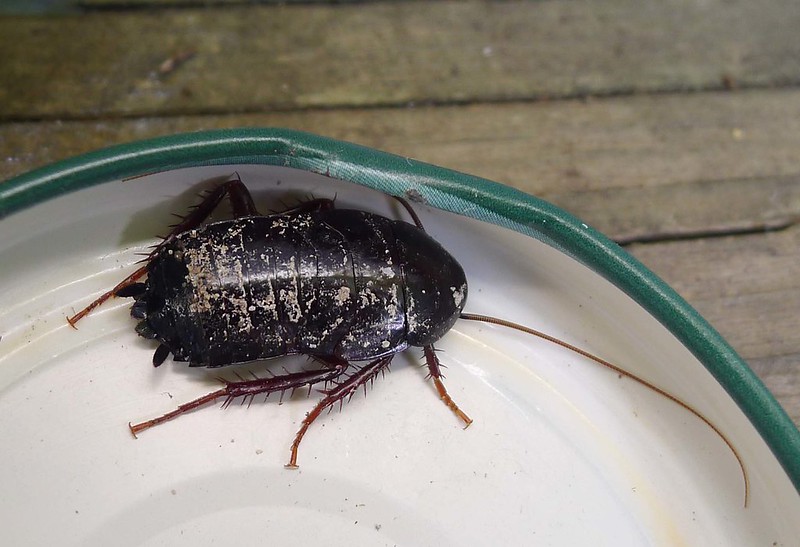
Found mainly in northern climates of the Usa, Oriental cockroaches are ofttimes mistaken for beetles due to their thick and round shape or water bugs, as they typically enter homes through h2o drains. Oriental cockroaches are dark brown to almost black and average around 1 1/4 inches long and don't fly. Due to the foul odor they emit, they are considered one of the filthiest roaches. Outdoors, Oriental roaches live in clammy areas like sewer systems, bleed pipes, woodpiles, h2o meter boxes, trash cans and trash piles, pet feeding areas, under moist areas of the business firm and in densely vegetated bloom beds.
Smokeybrown Cockroach
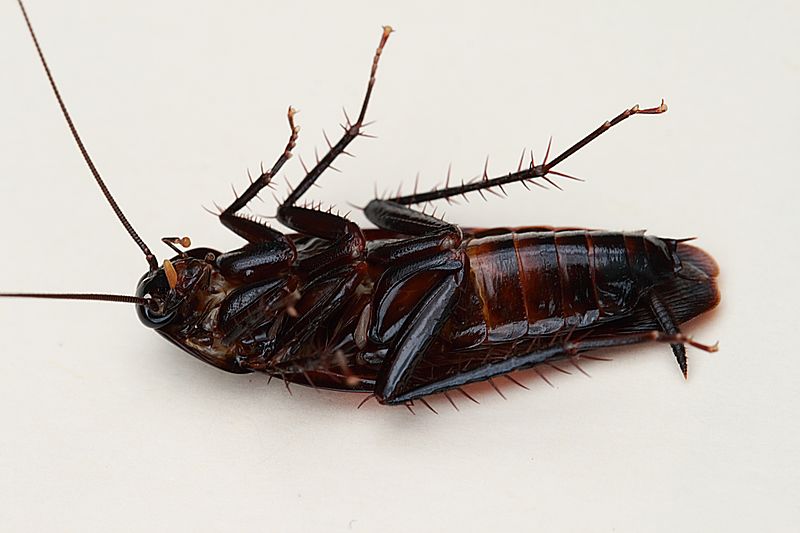
Often mistaken for an American cockroach, the Smokeybrown cockroach is uniformly dark dark-brown or mahogany colored and shiny and lacks the yellow markings on the head. Information technology averages around ane-1/iv inches long and is a good flyer. Although typically plant in warm locations, the roach tin besides inhabit northern locales. These cockroaches require water every three to 4 days, and so y'all are likely to detect them outdoors in clammy areas that are warm and dark. Typical hiding places include the awning of palm trees, holes in trees, within mulch in flower beds and cracks in block walls.
Dark-brown-Banded Cockroach
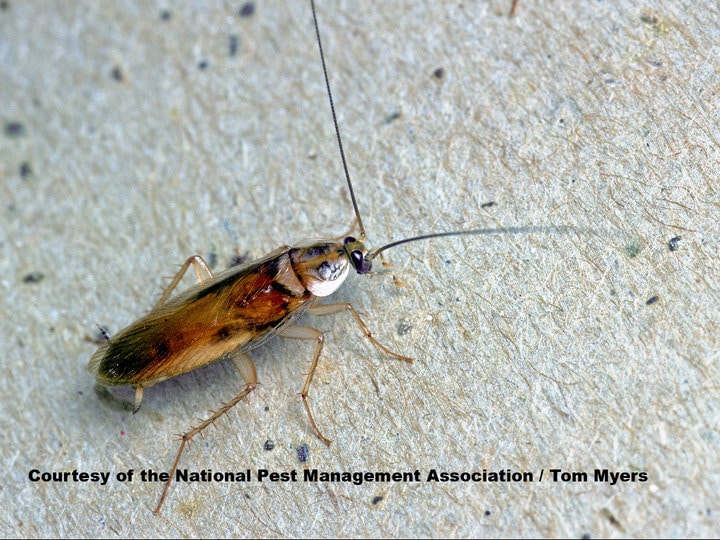
Dark-brown-banded cockroaches were first introduced from Cuba into Miami, and now reside in all portions of the United States. Due to their minor size of around 5/8 inches long, they are oftentimes mistaken for German cockroaches. Females are ruby-brown to nighttime-brownish and males are dark-chocolate-brown, with both having two yellow bands across their bodies. Only the males can wing. The roach prefers a warm outdoor environment and reside around electrical equipment, pet feeding stations, frames around windows and whatever warm and secluded location.
Turkestan Cockroach
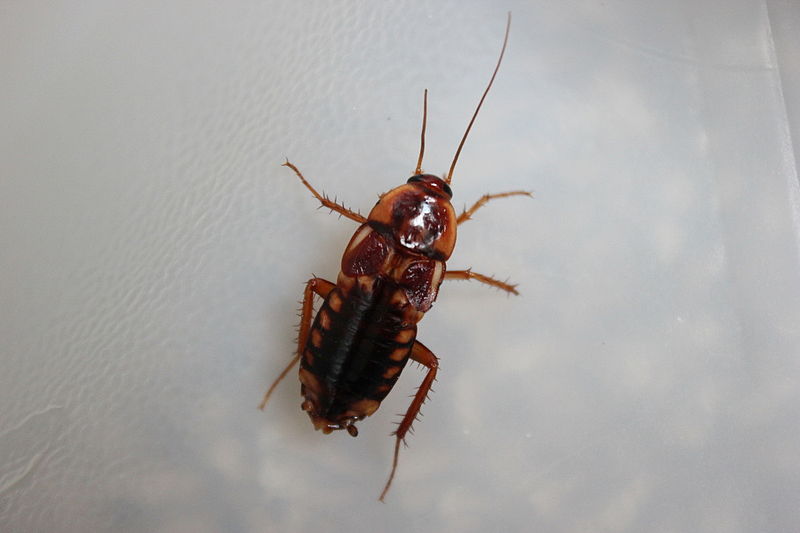
Turkestan cockroaches are around 1 inch long, with females oftentimes being confused with Oriental roaches and the males with the American cockroach. However, you can distinguish the females by the cream-colored markings on their bodies and the males are smaller than American types, with tannish-yellow wings and edges that are foam-colored. Outdoors, you tin can usually observe them in potted plants, leafage debris, compost piles, h2o meter boxes, and cracks and crevices in physical.
Once you are able to place the particular cockroach species, you are better able to observe their hiding place and perform methods of pest-control and prevention to control present and future roach problems.
Outdoor Cockroach Management Tips
Controlling and the prevention of an outdoor roach problem involve several steps. The University of Florida notes that an integrated pest direction approach (IPM) is lxxx percent successful in the elimination of the roach infestation and prevention of future roach problems.
The first stride in managing your outdoor cockroaches is prevention and sanitation, which likewise assists in preventing the roaches from finding an entry bespeak inside the home. Prevention and sanitation are broken into 4 categories: exclusion, and eliminating h2o sources, food sources and harborages.
1. Exclusion
- Keep doors and windows leading from the outside shut.
- Repair any opening in soffit and window screens to prevent roach entry into the home.
- Caulk openings around pipes or plumbing, cracks around windows, doors and electrical outlets inbound the dwelling.
- Screen or seal openings around sewer vents or drainage lines and attic vents.
ii. Eliminate Sources of H2o
- Eliminate outdoor h2o collection areas such every bit old tires, holes in trees, waste matter such as sometime pans and cans lying around.
- Don't overwater your plants where the expanse remains moisture for long periods.
- Repair leaking hoses or plumbing pipes.
- Empty outdoor water dishes for pets daily.
3. Eliminate Sources of Food
- Keep compost piles sealed.
- Dispose of outdoor trash properly and don't leave laying around.
- Go on lids on trash cans.
- Empty outdoor nutrient bowls for pets daily.
4. Harborages Emptying
- Seal cracks and crevices around the outside of the dwelling house, equally an adult cockroach can fit into spaces every bit small equally 1/16th of an inch.
- Continue whatever organic mulch pulled dorsum from the house past well-nigh 1 foot, every bit adult roaches prolifically breed in the organic thing. Alice Covington suggests replacing organic blossom bedmulches, especially around the firm with an inorganic material like gravel or pebbles, as the roaches won't accept upwards home or breed in those materials.
- Proceed any firewood or woodpiles stacked off the ground and kept away from the house.
- Proceed any shrubbery planted around the firm trimmed and maintained so it doesn't touch the house or roof area. According to the University of Florida, roaches observe ivy a favorite breeding location.
- Fill any holes in copse with cement.
- Clean up whatever trash or debris in the 1000 where roaches tin find a safety identify to hibernate.
Chemical Pest Control
After taking the four steps above, information technology's time to suspension out the roach-killing chemicals.
Baits
Using cockroach baits are suggested due to their effectiveness and the awarding being targeted. Baits come in various forms but when used outdoors, granules and gels piece of work best. When using cockroach baits, never utilise a spray insecticide in the same location, as it volition repel any cockroach species from entering the area.
- Apply granule cockroach baits around the perimeter of your firm, in flower beds and mulched areas.
- Apply cockroach gel baits in whatever crevices or cracks in outdoor walls, foundations or around doors and windows.
Insecticidal Sprays
As long as you aren't applying in baited areas outdoors, insecticidal sprays labeled for outdoor employ can besides exist constructive. When using any type of pest-command production, always follow directions on utilise and echo applications. Keep children and pets out of the treated areas.
- Spray any cracks or crevices around doors or windows where you lot suspect the cockroaches are using as a hiding place.
- Seal any foundation cracks or crevices. Spray effectually the perimeter of the home'due south foundation and any entry points into the home where larger cockroaches can enter.
Always wash your hands afterward applying any insecticide or use protective gloves when applying.
Good Tip:Although there are insecticidal dusts used for cockroach problems, the vast majority contain boric acrid. It is highly toxic to plants and becomes ineffective once moisture. Their utilise is most effective when controlling an indoor cockroach infestation.
Staying Roach-Free
If y'all don't feel like tackling the outdoor roach trouble yourself or just the thought of the muddy pest gives you the heebie jeebies, y'all can always call in a professional pest-control company. Professionals are licensed to use products that aren't available to the general public. They also accept experience dealing with cockroaches in the landscape.
Whether you decide to do the job yourself or hire someone else, some chores are on you.
- Periodically go out and making certain the exterior surface area is clean.
- Trim vegetation.
- Seal any cracks or crevices in the home.
- Eliminate any potential hiding places.
Taking these steps will go a long manner in preventing time to come outdoor cockroach infestations. Although zippo tin guarantee a perfectly roach-complimentary landscape, continued maintenance of your outdoor infinite and pest-command treatments will eliminate the vast majority of the filthy pests.
Chief epitome credit: American cockroach, Mr. TinDC, CC 2.0
![]()
Joyce Starr
Joyce Starr has been writing on horticultural and landscaping topics for over 15 years. In addition, for the by 20 years she's endemic and operated a landscaping and design business. She shares her experience and passion for all things greenish through her writing.
goodletsiblens1982.blogspot.com
Source: https://www.lawnstarter.com/blog/pest-control/getting-rid-of-cockroaches-outside/
0 Response to "Best Cockroach Killer for Around Outsode of House"
Post a Comment